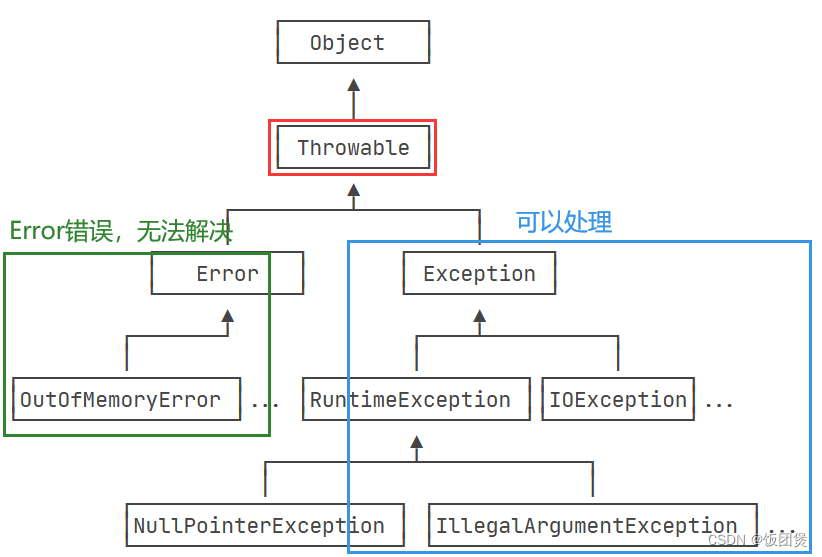Java内置了一套异常处理机制,总是使用异常来表示错误。一个健壮的程序必须处理各种各样的错误。所谓错误,就是程序调用某个函数的时候,如果失败了,就表示出错
异常是一种class,因此它本身带有类型信息。异常可以在任何地方抛出,但只需要在上层捕获,这样就和方法调用分离了:
try {String s = processFile(“C:\\test.txt”);// ok:
} catch (FileNotFoundException e) {// file not found:
} catch (SecurityException e) {// no read permission:
} catch (IOException e) {// io error:
} catch (Exception e) {// other error:
}因为Java的异常是class,它的继承关系如下:

从继承关系可知:Throwable是异常体系的根,它继承自Object。Throwable有两个体系:Error和Exception,Error表示严重的错误,程序对此一般无能为力,例如:
OutOfMemoryError:内存耗尽NoClassDefFoundError:无法加载某个ClassStackOverflowError:栈溢出
而Exception则是运行时的错误,它可以被捕获并处理。
某些异常是应用程序逻辑处理的一部分,应该捕获并处理。例如:
NumberFormatException:数值类型的格式错误FileNotFoundException:未找到文件SocketException:读取网络失败
还有一些异常是程序逻辑编写不对造成的,应该修复程序本身。例如:
NullPointerException:对某个null的对象调用方法或字段IndexOutOfBoundsException:数组索引越界
Exception又分为两大类:
RuntimeException以及它的子类;- 非
RuntimeException(包括IOException、ReflectiveOperationException等等)
Java规定:
-
必须捕获的异常,包括
Exception及其子类,但不包括RuntimeException及其子类,这种类型的异常称为Checked Exception。 -
不需要捕获的异常,包括
Error及其子类,RuntimeException及其子类。
捕获异常
捕获异常使用try...catch语句,把可能发生异常的代码放到try {...}中,然后使用catch捕获对应的Exception及其子类:
import java.io.UnsupportedEncodingException;
import java.util.Arrays;public class Main {public static void main(String[] args) {byte[] bs = toGBK("中文");System.out.println(Arrays.toString(bs));}static byte[] toGBK(String s) {try {// 用指定编码转换String为byte[]:return s.getBytes("GBK");} catch (UnsupportedEncodingException e) {// 如果系统不支持GBK编码,会捕获到UnsupportedEncodingException:System.out.println(e); // 打印异常信息return s.getBytes(); // 尝试使用用默认编码}}
}
如果我们不捕获UnsupportedEncodingException,会出现编译失败的问题:
import java.io.UnsupportedEncodingException;
import java.util.Arrays;public class Main {public static void main(String[] args) {byte[] bs = toGBK("中文");System.out.println(Arrays.toString(bs));}static byte[] toGBK(String s) {return s.getBytes("GBK");}
}![]()
编译器会报错,错误信息类似:unreported exception UnsupportedEncodingException; must be caught or declared to be thrown,并且准确地指出需要捕获的语句是return s.getBytes("GBK");。意思是说,像UnsupportedEncodingException这样的Checked Exception,必须被捕获。
这是因为String.getBytes(String)方法定义是:
public byte[] getBytes(String charsetName) throws UnsupportedEncodingException {...
}
在方法定义的时候,使用throws Xxx表示该方法可能抛出的异常类型。调用方在调用的时候,必须强制捕获这些异常,否则编译器会报错。
在toGBK()方法中,因为调用了String.getBytes(String)方法,就必须捕获UnsupportedEncodingException。我们也可以不捕获它,而是在方法定义处用throws表示toGBK()方法可能会抛出UnsupportedEncodingException,就可以让toGBK()方法通过编译器检查:
public class Main {public static void main(String[] args) {byte[] bs = toGBK("中文");System.out.println(Arrays.toString(bs));}static byte[] toGBK(String s) throws UnsupportedEncodingException {return s.getBytes("GBK");}
}上述代码仍然会得到编译错误,但这一次,编译器提示的不是调用return s.getBytes("GBK");的问题,而是byte[] bs = toGBK("中文");。因为在main()方法中,调用toGBK(),没有捕获它声明的可能抛出的UnsupportedEncodingException。
修复方法是在main()方法中捕获异常并处理:
public class Main {public static void main(String[] args) {try {byte[] bs = toGBK("中文");System.out.println(Arrays.toString(bs));} catch (UnsupportedEncodingException e) {System.out.println(e);}}static byte[] toGBK(String s) throws UnsupportedEncodingException {// 用指定编码转换String为byte[]:return s.getBytes("GBK");}
}可见,只要是方法声明的Checked Exception,不在调用层捕获,也必须在更高的调用层捕获。所有未捕获的异常,最终也必须在main()方法中捕获,不会出现漏写try的情况。这是由编译器保证的。main()方法也是最后捕获Exception的机会。
如果是测试代码,上面的写法就略显麻烦。如果不想写任何try代码,可以直接把main()方法定义为throws Exception,因为main()方法声明了可能抛出Exception,也就声明了可能抛出所有的Exception,因此在内部就无需捕获了。代价就是一旦发生异常,程序会立刻退出。
public class Main {public static void main(String[] args) throws Exception {byte[] bs = toGBK("中文");System.out.println(Arrays.toString(bs));}static byte[] toGBK(String s) throws UnsupportedEncodingException {// 用指定编码转换String为byte[]:return s.getBytes("GBK");}
}还有在toGBK()内部“消化”异常:
static byte[] toGBK(String s) {try {return s.getBytes("GBK");} catch (UnsupportedEncodingException e) {// 什么也不干}return null;
这种捕获后不处理的方式是非常不好的,即使真的什么也做不了,也要先把异常记录下来:
static byte[] toGBK(String s) {try {return s.getBytes("GBK");} catch (UnsupportedEncodingException e) {// 先记下来再说:e.printStackTrace();}return null;
所有异常都可以调用printStackTrace()方法打印异常栈,这是一个简单有用的快速打印异常的方法。
- Java使用异常来表示错误,并通过
try ... catch捕获异常; - Java的异常是
class,并且从Throwable继承; Error是无需捕获的严重错误,Exception是应该捕获的可处理的错误;RuntimeException无需强制捕获,非RuntimeException(Checked Exception)需强制捕获,或者用throws声明;- 不推荐捕获了异常但不进行任何处理。





)




安装)



)




